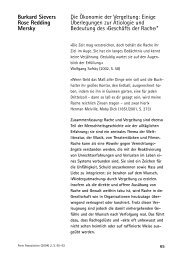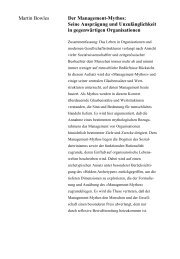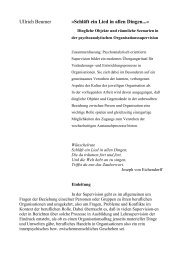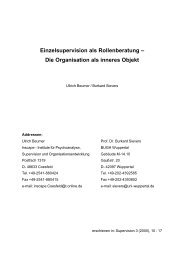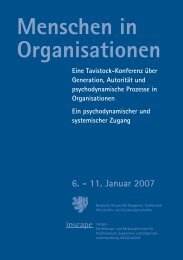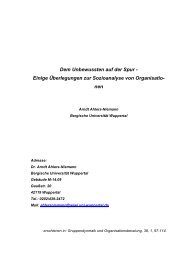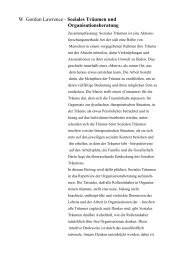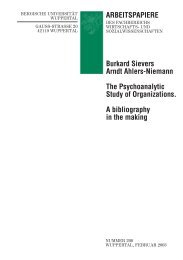Curing the monster Some images of and considerations - Prof. Dr ...
Curing the monster Some images of and considerations - Prof. Dr ...
Curing the monster Some images of and considerations - Prof. Dr ...
You also want an ePaper? Increase the reach of your titles
YUMPU automatically turns print PDFs into web optimized ePapers that Google loves.
- 16 -<br />
machine" (Berg 1987a). There can be no doubt that "<strong>the</strong> dragon itself is powerful,<br />
ruthless, determined - but not necessarily evil. It is people, who cannot st<strong>and</strong> things<br />
<strong>the</strong>y cannot control, who see cruelty <strong>and</strong> viciousness in him" (ibid.).<br />
What <strong>the</strong> dragon in <strong>the</strong> SCOS-logo is supposed to symbolize for our contemporary<br />
institutions <strong>and</strong> our work enterprises, in particular, is a different metamyth from <strong>the</strong><br />
glittering <strong>and</strong> sterile pseudo-reality as it is expressed in <strong>the</strong> best-selling soap<br />
operas on corporate culture <strong>and</strong> <strong>the</strong> related search for excellence. The dragon in<br />
this newly created version may get <strong>the</strong> previously explored function <strong>of</strong> <strong>the</strong><br />
avantgarde in order to help us to create a new tradition <strong>of</strong> looking backwards to<br />
previous dragon myths <strong>and</strong> <strong>images</strong> in order to (re)discover that <strong>the</strong>re may be o<strong>the</strong>r<br />
ways to cope with a dragon than just to annihilate it. It may even be <strong>the</strong> case that,<br />
by referring to <strong>the</strong> Chinese version <strong>of</strong> <strong>the</strong> dragon, we may discover new ways to<br />
help wisdom out <strong>of</strong> <strong>the</strong> wheel-chairs where it has been dislocated societally, in<br />
order to incorporate it in our organizations again (cf. Sievers 1986 a/b). The<br />
dragon tearing down <strong>the</strong> organization-chart may thus e.g. help us to perceive our<br />
history <strong>of</strong> industrialization from a new tradition, i.e. <strong>the</strong> repression <strong>and</strong><br />
imprisonment <strong>of</strong> that part <strong>of</strong> reality which cannot be counted <strong>and</strong> measured.<br />
So far as <strong>the</strong> image <strong>of</strong> <strong>the</strong> "dragon breaking out <strong>of</strong> <strong>the</strong> corporate psychic prison"<br />
(Berg 1987a) in <strong>the</strong> SCOS-logo is concerned, I found two pictures which caught<br />
my thoughts <strong>and</strong> which may help on fur<strong>the</strong>r attempts to perceive <strong>the</strong> mythology <strong>of</strong><br />
this logo. The first one obviously is well-known; it is <strong>the</strong> front page <strong>of</strong> <strong>the</strong> first<br />
English edition <strong>of</strong> Thomas Hobbes' 'Leviathan', which appeared in London in<br />
1651.<br />
Figure 7: Front page <strong>of</strong> <strong>the</strong> first English edition <strong>of</strong> Thomas Hobbes'<br />
"Leviathan" (1651); ill. By Wenceslaus Hollar, Mansell Collection, London;<br />
from: Vr<strong>and</strong>t 1987<br />
The Leviathan, in <strong>the</strong> Judaic tradition, is <strong>the</strong> cosmic dragon which along with his<br />
counterpart Behemot was created at <strong>the</strong> beginning <strong>of</strong> <strong>the</strong> world (cf. Steffen 1984:<br />
83 f., 112 ff., 142 ff.). Althoug this cannot be <strong>the</strong> occasion to argue about <strong>the</strong><br />
meaning <strong>and</strong> <strong>the</strong> possible failure <strong>of</strong> <strong>the</strong> Leviathan as a political symbol - a point



